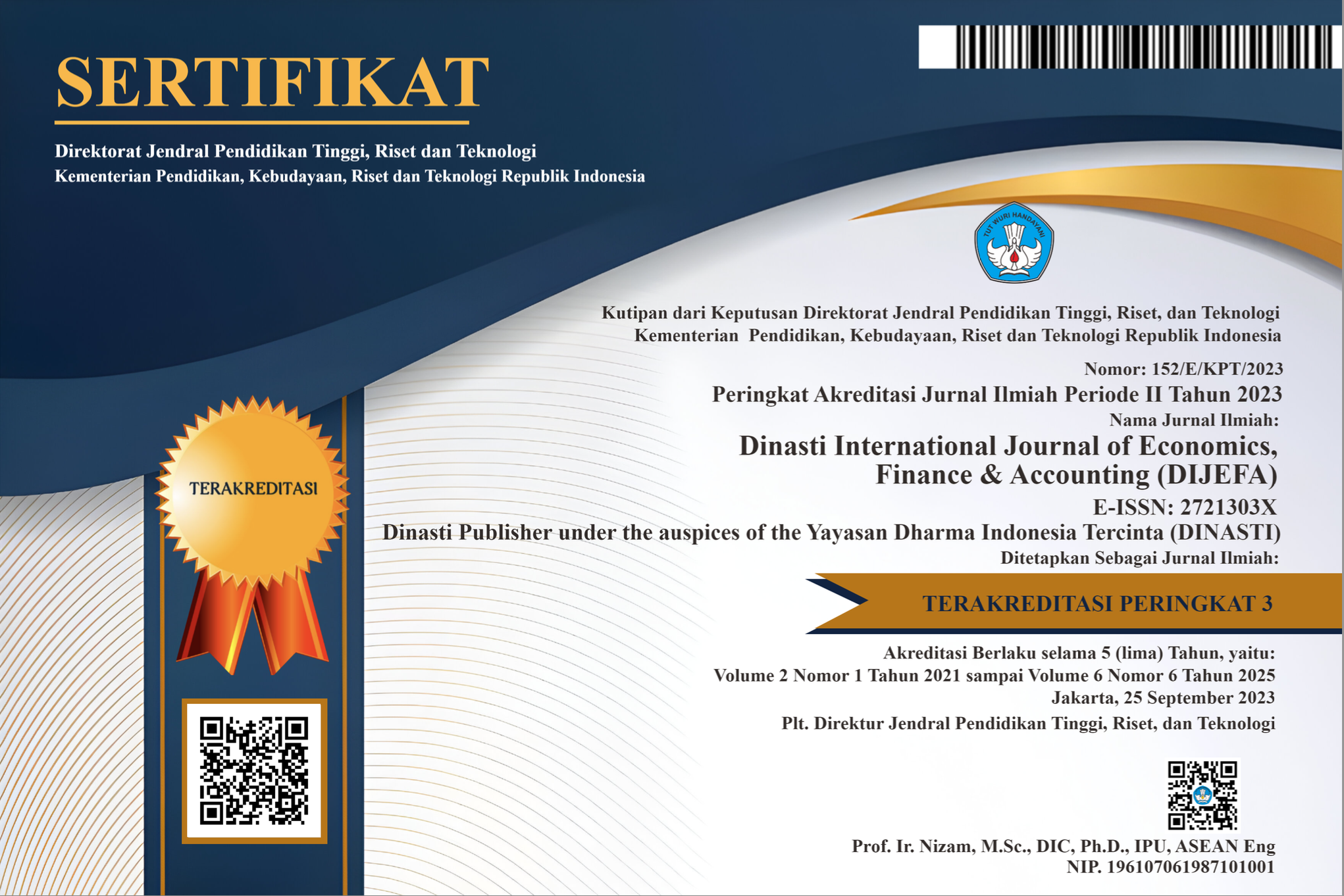Digital Transformation and E-Commerce Growth: Impact on Consumer Behavior and SMEs
DOI:
https://doi.org/10.38035/dijefa.v5i5.3438Keywords:
Consumer Behavior, E-Commerce Growth, Digital TransformationAbstract
This study investigates the factors influencing online shopping interest and consumer trust in e-commerce platforms, focusing on the Shopee platform. Through surveys and interviews with MSME players, the study reveals that perceived risk, particularly psychological risk, does not significantly affect online shopping interest or consumer trust. Conversely, perceived usefulness, especially in terms of time-saving, positively and significantly influences both online shopping interest and trust. While electronic word-of-mouth (e-WOM) does not impact online shopping interest, it positively and substantially affects trust. Trust mediates the relationship between perceived usefulness and online shopping interest, as well as between e-WOM and online shopping interest. These findings highlight the complexity of factors influencing online shopping behavior and underscore trust's critical role in mediating these relationships. The implications suggest that e-commerce platforms should enhance perceived usefulness and consumer trust through improved service and product quality, and active customer engagement. Strategies include improving customer service quality, incentivizing positive reviews, and ensuring transparency in return policies and data privacy. MSME players can leverage these insights to develop more effective marketing strategies, boost consumer engagement, and strengthen consumer relationships in the e-commerce environment.
References
Ahdiat, A. (2024). 5 E-Commerce dengan Pengunjung Terbanyak Sepanjang 2023. Https://Databoks.Katadata.Co.Id/. https://databoks.katadata.co.id/datapublish/2024/01/10/5-e-commerce-dengan-pengunjung-terbanyak-sepanjang-2023
Ahmad, A., Abuhashesh, M., Obeidat, Z., & ... (2020). E-WOM and airline e-ticket purchasing intention: Mediating effect of online passenger trust. Management Science …. http://growingscience.com/beta/msl/3860-e-wom-and-airline-e-ticket-purchasing-intention-mediating-effect-of-online-passenger-trust.html
Aisyah, D., & Engriani, Y. (2019). Pengaruh Reputasi, Kualitas Informasi, dan e-WOM terhadap Minat Beli pada Situs Jual Beli Online Tokopedia yang Dimediasi oleh Kepercayaan Pelanggan. Jurnal Kajian Manajemen Dan Wirausaha, 1(4).
Ajzen, I. (1991). The theory of planned behavior. Organizational Behavior and Human Decision Processes, 50(2), 179–211. https://doi.org/https://doi.org/10.1016/0749-5978(91)90020-T
Ajzen, I. (2020). The theory of planned behavior?: Frequently asked questions. Human Behavior and Emerging Technologies, 2(4), 314–324. https://doi.org/10.1002/hbe2.195
Amiruddin, M. R., Alwan, S., Riswanto, W. E., & Fantini, E. (2023). The Influence of Online Shopping on Lazada E-Commerce on Rational Consumer Behavior of the Millennial Generation in Tangerang. Indonesian Journal of Contemporary Multidisciplinary Research, 2(6), 1155–1166. https://doi.org/https://doi.org/10.55927/modern.v2i6.6699
Annur, C. M. (2024). Ini Sederet Faktor Utama Pendorong Belanja Online di Indonesia, Apa Saja? Https://Databoks.Katadata.Co.Id/. https://databoks.katadata.co.id/datapublish/2024/02/29/ini-sederet-faktor-utama-pendorong-belanja-online-di-indonesia-apa-saja
Apau, R., & Koranteng, F. N. (2019). Impact of Cybercrime and Trust on the Use of E-Commerce Technologies: An Application of the Theory of Planned Behavior. International Journal of Cyber Criminology, 13(2). https://doi.org/10.5281/zenodo.3697886
Apriani, A., & Wahdiniawati, S. A. (2023a). Small Medium Enterprises Transforming to Digital given E-Commerce Users’ Intention to Shop Online. Dinasti International Journal of Management Science (DIJMS), 5(2), 243–257. https://doi.org/https://doi.org/10.31933/dijms.v5i2.2124
Apriani, A., & Wahdiniawati, S. A. (2023b). Small Medium Enterprises Transforming to Digital given E-Commerce Users’ Intention to Shop Online. Dinasti International Journal of Management Science, 5(2), 243–257. https://doi.org/https://doi.org/10.31933/dijms.v5i2.2124
Ariyanti, A., & Darmanto, R. F. (2020). Analisis Terhadap Faktor-Faktor Yang Mempengaruhi Minat Beli Konsumen Wardah Cosmetics. Jurnal Manajemen Kewirausahaan, 17(2), 143–154. https://doi.org/http://dx.doi.org/10.33370/jmk.v17i2.465
Armitage, C. J., & Conner, M. (2001). Efficacy of the theory of planned behaviour: A meta?analytic review. British Journal of Health Psychology, 40(4), 471–499. https://doi.org/https://doi.org/10.1348/014466601164939
Aslami, N., Apriani, A., Widayati, C. C., & Losi, R. V. (2022). The Role Of Trust In Mediating Perceived Ease Of Use, Perceived Risk And E-Wom On Purchase Intention. Jurnal Perspektif Manajerial Dan Kewirausahaan (JPMK), 2(2), 69–81.
Astuti, W., & Prijanto, B. (2021). Faktor yang Memengaruhi Minat Muzaki dalam Membayar Zakat Melalui Kitabisa.com: Pendekatan Technology Acceptance Model dan Theory of Planned Behavior. AL-MUZARA’AH, 9(1). https://doi.org/10.29244/jam.9.1.21-44
Ayunda, K. P., Achmad, E., & Emilia, E. (2023). Analisis pengaruh penggunaan e-commerce, media sosial dan sosial media marketing terhadap pendapatan usaha mikro kecil menengah (UMKM) fashion di Kota Jambi. E-Journal Perdagangan Industri Dan Moneter, 11(3), 28–41. https://doi.org/https://doi.org/10.22437/pim.v11i3.29655
Azhari, M. T., Bahri, A. F., Asrul, & Rafida, T. (2023). Metode Penelitian Kuantitatif. PT. Sonpedia Publishing Indonesia.
Bandura, A. (1991). Social cognitive theory of self-regulation. Organizational Behavior and Human Decision Processes, 50(2), 248–287. https://doi.org/https://doi.org/10.1016/0749-5978(91)90022-L
Bhandari, M., & Rodgers, S. (2019). What does the brand say? Effects of brand feedback to negative eWOM on brand trust and purchase intentions.
Bosnjak, M., Ajzen, I., & Schmidt, P. (2020). The theory of planned behavior: Selected recent advances and applications. Europe’s Journal of Psychology, 16(3), 352. https://doi.org/10.5964/ejop.v16i3.3107
Bulut, Z. A., & Karabulut, A. N. (2018). Examining the role of two aspects of eWOM in online repurchase intention: An integrated trust–loyalty perspective. Journal of Consumer Behaviour, 17(4), 407–417. https://doi.org/https://doi.org/10.1002/cb.1721
Cheung, C. M. ., & Lee, M. K. O. (2012). What drives consumers to spread electronic word of mouth in online consumer-opinion platforms. Decision Support Systems, 53(1), 218–225. https://doi.org/https://doi.org/10.1016/j.dss.2012.01.015
Davis, F. (1989). Technology acceptance model: TAM. Al-Suqri, MN, Al-Aufi, AS: Information Seeking Behavior and Technology Adoption, 205–219.
Eneizan, B., Alsaad, A., Alkhawaldeh, A., Rawash, H. N., & Enaizan, O. (2020). E-Wom, Trust, Usefulness, Ease Of Use, And Online Shopping Via Websites: The Moderating Role Of Online Shopping Experience. Journal of Theoretical and Applied Information Technology, 98(13).
Faradila, R. S. N., & Soesanto, H. (2016). Analisis Pengaruh Persepsi Kemudahan Penggunaan dan Persepsi Manfaat terhadap Minat Beli dengan Kepercayaan Sebagai Variabel Intervening (Studi pada Pengunjung Toko Online berrybenka.com di Kalangan Mahasiswa Universitas Diponegoro). Diponegoro Journal of Management, 5(3), 239–250.
Farivar, S., Turel, O., & Yuan, Y. (2017). A trust-risk perspective on social commerce use: an examination of the biasing role of habit. Internet Research, 27(3), 586–607. https://doi.org/https://doi.org/10.1108/IntR-06-2016-0175
Ghozali, I., & Latan, H. (2020). Partial Least Squares: Konsep, Teknik dan Aplikasi Menggunakan SmartPLS 3.0 Untuk Penelitian Empiris (Vol. 2). Universitas Diponegoro.
Gunawan, M. A., & Sukresna, I. M. (2023). Pengaruh Potongan Harga, Kenyamanan, Interaktivitas, Dan Keterlibatan Terhadap Niat Pembelian Impulsif Pada Fitur Live Streaming Di Platform E-Commerce. Diponegoro Journal of Management, 12(4).
Hair, J. J. F., Hult, G. T. M., Ringle, C. M., & Sarstedt, M. (2021). A primer on partial least squares structural equation modeling (PLS-SEM). Sage Publications.
Havidz, H. B. H., Hudaya, A., & Ali, H. (2020). Model Of Consumer Trust On Travel Agent Online: Analysis Of Perceived Usefulness And Security On Re Purchase Interests (Case Study Tiket.Com). Dinasti International Journal of Economics, Finance & Accounting, 1(1).
Ho, S. M., Ocasio-Velázquez, M., & Booth, C. (2017). Trust or consequences? Causal effects of perceived risk and subjective norms on cloud technology adoption. Computers & Security, 70, 581–595. https://doi.org/https://doi.org/10.1016/j.cose.2017.08.004
Ikhsani, K., Widayati, C. C., & Wuryandari, N. E. R. (2021). Analisis Pengaruh Persepsi Resiko, Promosi, Dan Kepercayaan Merek Terhadap Niat Beli Pasca Covid-19. Jurnal Bisnis, Ekonomi, Manajemen, Dan Kewirausahaan (JBEMK), 1(1). https://doi.org/https://doi.org/10.52909/jbemk.v1i1.31
Ilhamalimy, R. R., & Ali, H. (2021). Model Perceived Risk And Trust: E-Wom And Purchase Intention (The Role Of Trust Mediating In Online Shopping In Shopee Indonesia). Dinasti International Journal of Digital Business Management, 2(2). https://doi.org/https://doi.org/10.31933/dijdbm.v2i2.651
Immanuel, D. M., & May, T. (2022). Pengaruh Perceived Ease Of Use, Perceived Usefulness, Perceived Enjoyment, Perceived Risk, Dan E-Wom Terhadap Purchase Intention Pada Instagram Commerce. PERFORMA: Jurnal Manajemen Dan Start-Up Bisnis, 7(3).
Ismagilova, E., Dwivedi, Y. K., Slade, E., & Williams, M. D. (2017). Electronic Word of Mouth (eWOM) in the Marketing Context: A State of the Art Analysis and Future Directions. In SpringerBriefs in Business.
Karnadjaja, C. C., Tulipa, D., & Lukito, R. S. H. (2017). Pengaruh Persepsi Risiko, Manfaat, Dan Kemudahan Penggunaan Terhadap Minat Belanja Online Melalui Kepercayaan Dan Sikap Pada Konsumen Zalora Di Surabaya. Kajian Ilmiah Mahasiswa Manajemen, 6(2).
Kusumatrisna, A. L., Amri, K., Anggraini, L., Sutarsih, T., & Wulandari, V. C. (2023). Statistik eCommerce 2022/2023.
Larasetiati, M., & Ali, H. (2019). Model of Consumer Trust: Analysis of Perceived Usefulness and Security toward Repurchase Intention in Online Travel Agent. Saudi Journal of Economics and Finance, 3(8), 350–357. https://doi.org/10.21276/sjef.2019.3.8.5
Le-Hoang, P. V. (2020). Factors Affecting Online Purchase Intention: The Case Of E-Commerce On Lazada. Independent Journal Of Management & Production (IJM&P), 11(3). https://doi.org/10.14807/ijmp.v11i3.1088
LY, N. T. H., & LE-HOANG, P. V. (2020). Factors Influence Intention To Buy Smartphone: The Role Of E-Wom. International Journal of Management (IJM), 11(7), 953–961. https://doi.org/10.34218/IJM.11.7.2020.083
Marriott, H. R., & Williams, M. D. (2018). Exploring consumers perceived risk and trust for mobile shopping: A theoretical framework and empirical study. Journal of Retailing and Consumer Services, 42, 133–146. https://doi.org/https://doi.org/10.1016/j.jretconser.2018.01.017
Matute, J., Polo-Redondo, Y., & Utrillas, A. (2016). The influence of EWOM characteristics on online repurchase intention: Mediating roles of trust and perceived usefulness. Online Information Review, 40(7), 1090–1110. https://doi.org/https://doi.org/10.1108/OIR-11-2015-0373
McDaniel, C., & Gates, R. (2012). Marketing Research Essentials. Wiley Global Education.
Napawut, W., Siripipatthanakul, S., & ... (2022). The Mediating Effect of E-WOM on the Relationship Between Digital Marketing Activities and Intention to Buy Via Shopee. … Journal of Behavioral …. https://papers.ssrn.com/sol3/papers.cfm?abstract_id=4047441
Nugraha, T. P., Parlyna, R., & Hidayat, N. (2021). Pengaruh Kualitas Pelayanan dan Kepercayaan terhadap Kepuasan Pelanggan Pengguna Aplikasi Pembayaran X. Jurnal Bisnis, Manajemen, Dan …. http://pub.unj.ac.id/index.php/jbmk/article/view/245
Nur’Asia, N., & Muzakir, M. (2023). Pengaruh Kepercayaan, Persepsi Risiko Dan Komitmen Terhadap Minat Beli Kembali Konsumen Shopee. Jurnal Ilmu Manajemen Universitas Tadulako (JIMUT), 9(2), 121–131. https://doi.org/https://doi.org/10.22487/jimut.v9i2.326
Nur, A. M., Ghalib, S., & Utomo, S. (2020). Pengaruh Promosi Dan Harga Terhadap Minat Beli Yang Dimediasi Oleh Kepercayaan Pada Pelanggan Indihome Di Kota Palangka Raya (Studi Emperis Pada PT.Telkom Provinsi Kalimantan Tengah). JURNAL BISNIS DAN PEMBANGUNAN, 9(1). https://doi.org/http://dx.doi.org/10.20527/jbp.v9i1.8694
Pappas, I. O. (2018). User experience in personalized online shopping: a fuzzy-set analysis. European Journal of Marketing, 52(7/8), 1679–1703. https://doi.org/https://doi.org/10.1108/EJM-10-2017-0707
Pattikawa, S. N., & Hasan, G. (2023). Pengaruh Kepercayaan Dan Minat Repurchase Terhadap Perilaku Konsumen Dalam Berbelanja Di E-Commerce Kota Batam. Technomedia Journal, 8(1), 52–66. https://doi.org/https://doi.org/10.33050/tmj.v8i1.1938
Prasetyo, M. H., & Hasyim, H. (2021). Pengaruh Kualitas Produk, Harga Dan Kepercayaan Terhadap Minat Beli Produk Fashion Secara Online. Nusantara Hasana Journal, 1(1), 22–32.
Prastyo, N. A., Suharto, A., & Tyas, W. M. (2018). Pengaruh E-Wom (Electronic Word Of Mouth ) Dan Harga Terhadap Minat Beli Pada Online Shop. Universitas Muhammadiyah Jember.
Primadasa, Y., Saputra, A. Y., & Juliansa, H. (2021). Penerapan Metode Technology Acceptance Model Terhadap Faktor Kepercayaan dan Risiko Dalam Penggunan Aplikasi Fintech. CogITo Smart Journal, 7(2), 290–304. https://doi.org/https://doi.org/10.31154/cogito.v7i2.327.290-304
Puspitarini, D. A., & Dewi, I. R. (2021). Fraud risk and trust on the intention to buy of e-commerce. Journal of Contemporary Accounting, 3(1), 45–52. https://doi.org/https://doi.org/10.20885/jca.vol3.iss1.art5
Raharti, R., & Nasution, M. I. P. (2024). Analisis Dampak E-Commerce Terhadap Pengaruh Penjualan UMKM. Jurnal Riset Manajemen, 2(1), 171–178. https://doi.org/https://doi.org/10.54066/jurma.v2i1.1303
Raman, P. (2019). Understanding female consumers’ intention to shop online: The role of trust, convenience and customer service. Asia Pacific Journal of Marketing and Logistics, 31(4), 1138–1160. https://doi.org/https://doi.org/10.1108/APJML-10-2018-0396
Ramayah, T., Yeap, J. A. L., Ahmad, N. H., Halim, H. A., & Rahman, S. A. (2017). Testing a confirmatory model of Facebook usage in SmartPLS using consistent PLS. International Journal of Business and Innovation, 3(2).
Saputra, S. (2020). Pengaruh Electronic Word Of Mouth (E-Wom) Dan Citra Merek Terhadap Minat Belanja Konsumen Di Batam. Jurnal Ilmiah Manajemen Bisnis, 5(1), 1–11.
Sawitri, N. L. P. W., & Giantari, I. G. A. K. (2020). The Role of Trust Mediates the Effect of Perceived Ease of Use and Perceived Usefulness on Online Repurchase Intention. American Journal of Humanities and Social Sciences Research (AJHSSR), 4(1), 374–381.
Sekaran, U., & Bougie, R. (2017). Metode Penelitian untuk Bisnis: Pendekatan Pengembangan-Keahlian, Edisi 6 Buku 1 (6th ed.). Salemba Empat.
Silva, J., Pinho, J. C., Soares, A., & Sa, E. (2020). Antecedents Of Online Purchase Intention And Behaviour: Uncovering Unobserved Heterogeneity. Journal of Business Economics and Management, 20(1), 131–148. https://doi.org/https://doi.org/10.3846/jbem.2019.7060
Siregar, S. T., Lita, R. P., & Ma’ruf, M. (2023). Penerimaan Teknologi Oleh Pelaku UKM Kuliner Di Kota Padang Terhadap Layanan E-Commerce Shopeefood. Procuratio?: Jurnal Ilmiah Manajemen, 11(1), 32–51. https://doi.org/https://doi.org/10.35145/procuratio.v11i1.2821
Soto-Acosta, P., Molina-Castillo, F. J., Lopez-Nicolas, C., & Colomo-Palacios, R. (2014). The effect of information overload and disorganisation on intention to purchase online: The role of perceived risk and internet experience. Online Information Review, 38(4), 543–561. https://doi.org/https://doi.org/10.1108/OIR-01-2014-0008
Suleman, D., Ali, H., Nusraningrum, D., & Ali, M. M. (2019). Perceived Ease of Use, Trust and Risk toward Attitude and Intention in Shopping for Online Fashion Products In Indonesia. Archives of Business Research, 7(4). https://doi.org/https://doi.org/10.14738/abr.74.6482
Syaputra, D. Y. (2019). Analisis E-Wom, Perceived Value Dan Perceived Quality Terhadap Kepercayaan Dan Dampaknya Kepada Keputusan Pembelian Produk Fashion Di Situs Online Shop Indonesia (Pendekatan Structural Equation Modeling). Universitas Pembangunan Panca Budi.
Ulaan, R. V., Pangemanan, S. S., & Lambey, L. (2016). The Effect Of Perceived Enjoyment On Intention To Shop Online (The Study of Faculty of Economics and Business Sam Ratulangi University Manado). Jurnal EMBA?: Jurnal Riset Ekonomi, Manajemen, Bisnis Dan Akuntansi, 4(1), 1097–1220. https://doi.org/https://doi.org/10.35794/emba.4.1.2016.11871
Ventre, I., & Kolbe, D. (2020). The Impact of Perceived Usefulness of Online Reviews, Trust and Perceived Risk on Online Purchase Intention in Emerging Markets: A Mexican Perspective. Journal of International Consumer Marketing, 32(4), 287–299. https://doi.org/https://doi.org/10.1080/08961530.2020.1712293
Yudiarti, R. F. E., & Puspaningrum, A. (2018). The Role Of Trust As A Mediation Between The Effect Of Perceived Usefulness And Perceived Ease Of Use To Interest To Buy E-Book. Journal of Applied Management (JAM), 16(3). https://doi.org/http://dx.doi.org/ 10.21776/ub.jam.2018. 016.03.14
Yuriev, A., Dahmen, M., Paillé, P., Boiral, O., & Guillaumie, L. (2020). Pro-environmental behaviors through the lens of the theory of planned behavior: A scoping review. Resources, Conservation and Recycling, 155. https://doi.org/https://doi.org/10.1016/j.resconrec.2019.104660
Downloads
Published
How to Cite
Issue
Section
License
Copyright (c) 2024 Siti Annisa Wahdiniawati, Ari Apriani, Arthur Alvin Orlando

This work is licensed under a Creative Commons Attribution 4.0 International License.
Authors who publish their manuscripts in this journal agree to the following conditions:
- The copyright on each article belongs to the author(s).
- The author acknowledges that the Dinasti International Journal of Economics, Finance & Accounting (DIJEFA) has the right to be the first to publish with a Creative Commons Attribution 4.0 International license (Attribution 4.0 International (CC BY 4.0).
- Authors can submit articles separately, arrange for the non-exclusive distribution of manuscripts that have been published in this journal into other versions (e.g., sent to the author's institutional repository, publication into books, etc.), by acknowledging that the manuscript has been published for the first time in the Dinasti International Journal of Economics, Finance & Accounting (DIJEFA).


























































